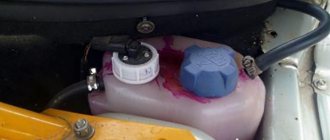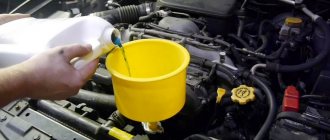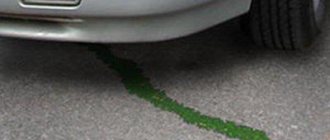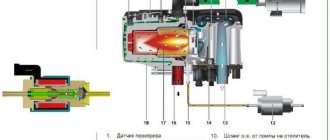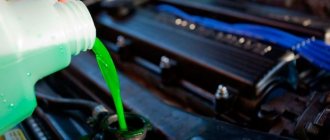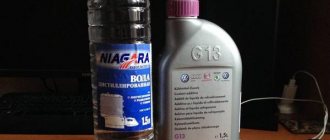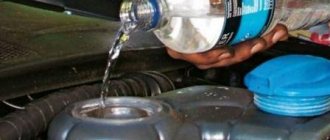I would not recommend making inquiries about whether it is possible to drive if antifreeze has leaked after such a nuisance has happened. This is a problem whose solution is better to know in advance, because it is impossible to predict at what moment and how badly the pipe will burst or the radiator will begin to leak.
If antifreeze has leaked, then the first thing to do is stop the car, and then act according to the instructions given further in my article. Happy reading, and at the end, if you have any questions, write them in the comments.
What consequences will occur if you continue driving without coolant?
The main task of any antifreeze is to remove excess heat from overheated engine parts. In fact, the composition is used to maintain operating temperature in the engine and in the car as a whole. On average, the temperature should be 85-97 degrees Celsius. For different types of cars, the characteristics may vary.
The internal combustion engine heats up gradually, and the most significant temperature load falls on the cylinders, pistons with rings, valves and individual parts of the cylinder head. It is in these places that metal elements come into direct contact with the flame when the fuel mixture burns. Hot gases also have a negative effect. The remaining parts of the engine heat up less intensely. When there is no refrigerant in the system, this can cause serious damage, namely:
- Without proper cooling, all of the listed mechanisms will heat up until they reach the specified strength limit. At a certain temperature, the metal will simply begin to melt, and under load it will lose its original shape.
- The internal stress in the cylinder block and pistons will increase. This will also lead to thermal deformation and cracks.
- In the absence of antifreeze, oil, the only liquid remaining in the system, will remove heat from the engine. This will lead to a rapid loss of lubricant quality and the formation of sludge.
Focusing even on these three points, we can definitely say that if the antifreeze has leaked, you absolutely cannot drive the car.
Leaking through the heater radiator
Here you definitely need to turn off the heater radiator, since liquid pouring into the cabin can damage the electronics or create other problems. Locate the two pipes that fit into the “baffle” between the engine and the passenger compartment. Disconnect them and muffle them in any way. If the design of the car allows it, then use the method described in paragraph 1.
Pipes to the heater radiator
If there is no source of water nearby, and all the antifreeze has leaked out, then you can drive for about 1 minute (depending on the make of the car). Then you need to let the engine cool for at least 15 minutes. If you have a choice to fill with water from a well, borehole or main water supply system, use well water. It is less rigid and will create a minimum of deposits on the walls of the cylinder jacket and in the radiator.
Good luck on the roads. Don't break.
How long can you drive a car without antifreeze?
Critical and irreversible changes in the operation of transport do not occur immediately, but after some time. This distance is individual for each car, so it is better not to conduct such experiments. If there is no other option at all and you have to drive without coolant, then you should be aware of a number of factors that influence the duration of the period before engine failure.
- ICE design. The more massive the parts and the stronger the material from which the unit is made, the more resistant the motor will be to high temperatures. It is likely that the motor will be able to withstand up to 10 minutes. The situation is completely different with modern aluminum engines, which will not last even 1-2 minutes without antifreeze.
- Air temperature. In winter, the engine will be additionally cooled and will be able to work longer. In summer, a critical situation can occur much faster.
- Motor operating mode. When driving without load and at idle speed, fuel consumption is less, which means the system does not heat up too much.
- General condition of the engine. A unit with low mileage will be able to last longer than an old engine. At the same time, it is easier for an engine with exhaust to withstand general overheating and thermal expansion without jamming.
Why does antifreeze leak?
The engine cooling system consists of several main elements, as well as connecting pipes. Antifreeze in the system is a mixture of water and concentrate in certain proportions. As the internal combustion engine heats up, the temperature of the coolant also increases; the coolant itself is in the system under a certain pressure. It is quite obvious that any defects in individual components associated with tightness will cause leaks. Problems can arise both with the elements themselves and with the pipes. Let us add that in some cases the driver may encounter the fact that antifreeze leaks when cold, leaks appear after the internal combustion engine warms up, the leak can be intense or unnoticeable (antifreeze leaves slowly or quickly), etc.
Ways to temporarily solve the problem with the cooler
The easiest way to fix the problem before arriving at the service station is to fill the radiator with plain water. Do not be afraid that water will harm the engine. This is possible only with the systematic use of liquid.
When the leak is too intense, it is worth plugging the radiator pipes. After this, all that remains is to turn the heater on to maximum and drive no more than 60-90 km/h. Overheating will be minimal, but you should monitor the temperature sensor. If the temperature exceeds 110 degrees, the car must be turned off.
Leakage through a burst pipe
Here you can try tying the pipe. To do this, with the engine off, tightly wrap the pipe with electrical tape or tape. If there is a small piece of rubber, apply it to the leak and wrap it tightly or secure it with clamps. This will not provide 100% tightness, but can significantly reduce the intensity of the leak. In the case of radiator pipes, it is better to completely plug them using the method described above.
Is it possible to drive without a cooler in winter?
This situation is also worth talking about, because my clients are often interested in this. The fact is that sometimes the refrigerant freezes in the system and causes drivers a lot of problems. So, you can’t drive in winter without a cooler either. Of course, driving a short distance is quite acceptable, but it’s not worth doing this all the time.
Previously, air-cooled engines were produced (this was installed on Zaporozhets), but today there are few such machines and modern units are made of massive alloy. A faulty cooling system can lead to deformation and then jamming of the engine. The situation can be corrected only by major repairs, and in some cases, only by replacement.
Is it possible to drive without antifreeze in winter?
The issue of winter driving without antifreeze is also relevant. It is not uncommon for the coolant in the cooling system to freeze. And sometimes the water that is not drained in cold weather simply ruptures the radiator. What to do, is it possible to drive in winter without coolant?
Here, too, the answer will be unequivocal: it’s impossible. Driving a short distance to move your car from an inconvenient location to a more suitable parking lot or to drive it to the nearest service center will most likely result without consequences. However, it will not be possible to drive constantly without antifreeze on a water-cooled engine, even in severe winter.
Some will now remember air-cooled engines, as, for example, on domestic motorcycles from the Soviet era or Zaporozhets cars. But here the situation is completely different. Motors were initially made massive, from an alloy that conducts heat well. For more efficient exhaust, designers installed special castings on the cylinders, the so-called cooling fins. And at the same time, air supply channels were made in the engine compartment, which were supposed to provide continuous airflow to the engine.
Liquid-cooled motors cannot be operated with a faulty cooling system, even in winter. A car with this problem can only be driven a minimum distance. But it is better to use the services of a tow truck or transport the car using a tow rope.
It's OK.
It's all nonsense. at -15 nothing will happen. Especially if you only added 1.2 liters of antifreeze. If the blast from the stove was even a little warm, then there was antifreeze in the system and was running where it needed to be. And the sensor is located at the outlet of the engine, so if the antifreeze in the engine was too hot, the sensor would show this and the fan would turn on, regardless of whether there is antifreeze in the radiator or not.
